6N137 Photocoupler: Datasheet, Pinout and Circuit
EVERLIGHT 6N137 Digital Output Optocoupler, 1 Channel, DIP, 8 Pins, 5 kV, 10 Mbps









EVERLIGHT 6N137 Digital Output Optocoupler, 1 Channel, DIP, 8 Pins, 5 kV, 10 Mbps
The 6N137 is an 8-pin dip high speed 10mbit/s logic gate photocoupler. This article enforces pinout, datasheet, schematic, circuit, and other details about 6N137.

Optocoupler 6N137
6N137 Pinout

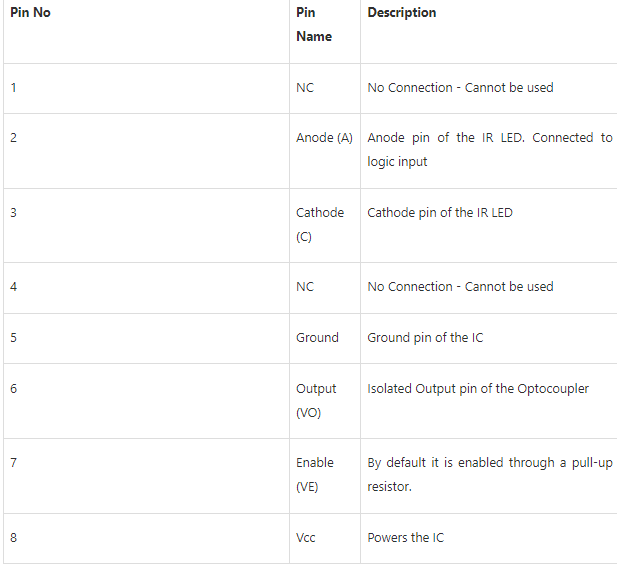
6N137 Description
The 6N137 consists of an infrared emitting diode optically coupled to a high-speed integrated photodetector logic gate with strobe output. It is packaged in an 8-pin DIP package and available in wide-lead spacing and SMD options.
6N137 CAD Model
Symbol

Footprint
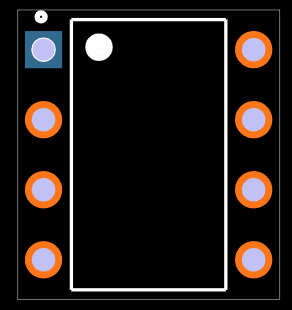
3D Model

6N137 Features
• High-speed 10Mbit/s
• 10kV/µs min. Common mode transient immunity (EL2611)
• Guaranteed performance from -40 to 85℃
• Logic gate output
• High isolation voltage between input and output (Viso=5000 V RMS )
• Pb free and RoHS compliant.
• UL approved (No. 214129)
• VDE approved (No. 132249)
• SEMKO approved
• NEMKO approved
• DEMKO approved
• FIMKO approved
• CSA approved (No. 2037145)
Specifications
- TypeParameter
- Factory Lead Time20 Weeks
- Mount
In electronic components, the term "Mount" typically refers to the method or process of physically attaching or fixing a component onto a circuit board or other electronic device. This can involve soldering, adhesive bonding, or other techniques to secure the component in place. The mounting process is crucial for ensuring proper electrical connections and mechanical stability within the electronic system. Different components may have specific mounting requirements based on their size, shape, and function, and manufacturers provide guidelines for proper mounting procedures to ensure optimal performance and reliability of the electronic device.
Through Hole - Mounting Type
The "Mounting Type" in electronic components refers to the method used to attach or connect a component to a circuit board or other substrate, such as through-hole, surface-mount, or panel mount.
Through Hole - Package / Case
refers to the protective housing that encases an electronic component, providing mechanical support, electrical connections, and thermal management.
8-DIP (0.300, 7.62mm) - Number of Pins8
- Shape
In electronic components, the parameter "Shape" refers to the physical form or outline of the component. It describes the external appearance of the component, including its dimensions, size, and overall structure. The shape of an electronic component can vary widely depending on its function and design requirements. Common shapes include rectangular, cylindrical, square, and circular, among others. The shape of a component is an important consideration in the design and layout of electronic circuits, as it can impact factors such as space utilization, heat dissipation, and ease of assembly.
RECTANGULAR - Number of Elements1
- Usage LevelIndustrial grade
- Operating Temperature
The operating temperature is the range of ambient temperature within which a power supply, or any other electrical equipment, operate in. This ranges from a minimum operating temperature, to a peak or maximum operating temperature, outside which, the power supply may fail.
-40°C~85°C - Packaging
Semiconductor package is a carrier / shell used to contain and cover one or more semiconductor components or integrated circuits. The material of the shell can be metal, plastic, glass or ceramic.
Tube - Published2008
- Pbfree Code
The "Pbfree Code" parameter in electronic components refers to the code or marking used to indicate that the component is lead-free. Lead (Pb) is a toxic substance that has been widely used in electronic components for many years, but due to environmental concerns, there has been a shift towards lead-free alternatives. The Pbfree Code helps manufacturers and users easily identify components that do not contain lead, ensuring compliance with regulations and promoting environmentally friendly practices. It is important to pay attention to the Pbfree Code when selecting electronic components to ensure they meet the necessary requirements for lead-free applications.
yes - Part Status
Parts can have many statuses as they progress through the configuration, analysis, review, and approval stages.
Active - Moisture Sensitivity Level (MSL)
Moisture Sensitivity Level (MSL) is a standardized rating that indicates the susceptibility of electronic components, particularly semiconductors, to moisture-induced damage during storage and the soldering process, defining the allowable exposure time to ambient conditions before they require special handling or baking to prevent failures
1 (Unlimited) - Additional Feature
Any Feature, including a modified Existing Feature, that is not an Existing Feature.
CMOS COMPATIBLE, UL APPROVED - Max Power Dissipation
The maximum power that the MOSFET can dissipate continuously under the specified thermal conditions.
100mW - Voltage - Supply
Voltage - Supply refers to the range of voltage levels that an electronic component or circuit is designed to operate with. It indicates the minimum and maximum supply voltage that can be applied for the device to function properly. Providing supply voltages outside this range can lead to malfunction, damage, or reduced performance. This parameter is critical for ensuring compatibility between different components in a circuit.
7V - Number of Functions1
- Voltage - Isolation
Voltage - Isolation is a parameter in electronic components that refers to the maximum voltage that can be safely applied between two isolated points without causing electrical breakdown or leakage. It is a crucial specification for components such as transformers, optocouplers, and capacitors that require isolation to prevent electrical interference or safety hazards. The voltage isolation rating ensures that the component can withstand the specified voltage without compromising its performance or safety. It is typically measured in volts and is an important consideration when designing circuits that require isolation between different parts of the system.
5000Vrms - Output Type
The "Output Type" parameter in electronic components refers to the type of signal or data that is produced by the component as an output. This parameter specifies the nature of the output signal, such as analog or digital, and can also include details about the voltage levels, current levels, frequency, and other characteristics of the output signal. Understanding the output type of a component is crucial for ensuring compatibility with other components in a circuit or system, as well as for determining how the output signal can be utilized or processed further. In summary, the output type parameter provides essential information about the nature of the signal that is generated by the electronic component as its output.
Open Collector - Configuration
The parameter "Configuration" in electronic components refers to the specific arrangement or setup of the components within a circuit or system. It encompasses how individual elements are interconnected and their physical layout. Configuration can affect the functionality, performance, and efficiency of the electronic system, and may influence factors such as signal flow, impedance, and power distribution. Understanding the configuration is essential for design, troubleshooting, and optimizing electronic devices.
SINGLE - Number of Channels1
- Voltage - Forward (Vf) (Typ)
The parameter "Voltage - Forward (Vf) (Typ)" in electronic components refers to the typical forward voltage drop across the component when it is conducting current in the forward direction. It is a crucial characteristic of components like diodes and LEDs, indicating the minimum voltage required for the component to start conducting current. The forward voltage drop is typically specified as a typical value because it can vary slightly based on factors such as temperature and manufacturing tolerances. Designers use this parameter to ensure that the component operates within its specified voltage range and to calculate power dissipation in the component.
1.4V - Propagation Delay
the flight time of packets over the transmission link and is limited by the speed of light.
75 ns - Input Type
Input type in electronic components refers to the classification of the signal or data that a component can accept for processing or conversion. It indicates whether the input is analog, digital, or a specific format such as TTL or CMOS. Understanding input type is crucial for ensuring compatibility between different electronic devices and circuits, as it determines how signals are interpreted and interacted with.
DC - Turn On Delay Time
Turn-on delay, td(on), is the time taken to charge the input capacitance of the device before drain current conduction can start.
75 ns - Optoelectronic Device Type
Optoelectronic Device Type refers to the classification of electronic components that can both detect and emit light. These devices convert electrical signals into light or vice versa, making them essential for applications such as optical communication, sensing, and display technologies. Common types of optoelectronic devices include light-emitting diodes (LEDs), photodiodes, phototransistors, and laser diodes. Understanding the optoelectronic device type is crucial for selecting the appropriate component for a specific application based on factors such as wavelength, power output, and sensitivity.
LOGIC IC OUTPUT OPTOCOUPLER - Forward Current
Current which flows upon application of forward voltage.
50mA - Max Output Voltage
The maximum output voltage refers to the dynamic area beyond which the output is saturated in the positive or negative direction, and is limited according to the load resistance value.
7V - Response Time
the time taken for a circuit or measuring device, when subjected to a change in input signal, to change its state by a specified fraction of its total response to that change.
4e-8 ns - Data Rate
Data Rate is defined as the amount of data transmitted during a specified time period over a network. It is the speed at which data is transferred from one device to another or between a peripheral device and the computer. It is generally measured in Mega bits per second(Mbps) or Mega bytes per second(MBps).
10Mbps - Direction
In electronic components, the parameter "Direction" refers to the orientation or alignment in which the component is designed to operate effectively. This parameter is particularly important for components such as diodes, transistors, and capacitors, which have specific polarity or orientation requirements for proper functionality. For example, diodes allow current flow in one direction only, so their direction parameter indicates the correct orientation for current flow. Similarly, polarized capacitors have a positive and negative terminal, requiring proper alignment for correct operation. Understanding and adhering to the direction parameter is crucial for ensuring the reliable and efficient performance of electronic components in a circuit.
Unidirectional - Output Current per Channel
Output Current per Channel is a specification commonly found in electronic components such as amplifiers, audio interfaces, and power supplies. It refers to the maximum amount of electrical current that can be delivered by each individual output channel of the component. This parameter is important because it determines the capacity of the component to drive connected devices or loads. A higher output current per channel means the component can deliver more power to connected devices, while a lower output current may limit the performance or functionality of the component in certain applications. It is crucial to consider the output current per channel when selecting electronic components to ensure they can meet the power requirements of the intended system or setup.
50mA - Rise Time
In electronics, when describing a voltage or current step function, rise time is the time taken by a signal to change from a specified low value to a specified high value.
75ns - Fall Time (Typ)
Fall Time (Typ) is a parameter used to describe the time it takes for a signal to transition from a high level to a low level in an electronic component, such as a transistor or an integrated circuit. It is typically measured in nanoseconds or microseconds and is an important characteristic that affects the performance of the component in digital circuits. A shorter fall time indicates faster switching speeds and can result in improved overall circuit performance, such as reduced power consumption and increased data transmission rates. Designers often consider the fall time specification when selecting components for their circuits to ensure proper functionality and efficiency.
75 ns - Rise / Fall Time (Typ)
The parameter "Rise / Fall Time (Typ)" in electronic components refers to the time it takes for a signal to transition from a specified low level to a specified high level (rise time) or from a high level to a low level (fall time). It is typically measured in nanoseconds or picoseconds and is an important characteristic in determining the speed and performance of a component, such as a transistor or integrated circuit. A shorter rise/fall time indicates faster signal switching and can impact the overall speed and efficiency of a circuit. Designers often consider this parameter when selecting components for high-speed applications to ensure proper signal integrity and timing.
40ns 10ns - On-State Current-Max
The parameter "On-State Current-Max" in electronic components refers to the maximum current that can flow through the component when it is in the fully conducting state, also known as the "on-state." This parameter is crucial for determining the maximum load that the component can handle without getting damaged. It is typically specified in the component's datasheet and is important for ensuring the safe and reliable operation of the component within its specified limits. Designers and engineers use this parameter to select components that can handle the required current levels in their circuits without exceeding the maximum ratings.
0.05A - Propagation Delay tpLH / tpHL (Max)
Propagation delay tpLH and tpHL refer to the time it takes for a digital signal to travel through a logic gate or other electronic component. tpLH is the maximum time delay for the output to transition from a low state to a high state, while tpHL is the maximum time delay for the output to transition from a high state to a low state. These parameters are critical for determining the speed and timing performance of digital circuits, as they impact how quickly signals can propagate through the system and affect overall operation.
75ns, 75ns - Common Mode Transient Immunity (Min)
Common Mode Transient Immunity (Min) is a parameter that measures the ability of an electronic component to withstand and reject common mode noise or interference signals. Common mode noise refers to unwanted signals that are present on both input and output lines of a component. The minimum value of Common Mode Transient Immunity indicates the minimum level of noise or interference that the component can tolerate without affecting its performance. A higher Common Mode Transient Immunity value signifies better protection against common mode noise, ensuring reliable operation of the component in noisy environments. It is an important specification to consider when designing circuits that are exposed to external disturbances or electromagnetic interference.
5kV/μs - Inputs - Side 1/Side 2
The parameter "Inputs - Side 1/Side 2" in electronic components refers to the configuration of input connections on the component. It indicates which side of the component is designated as Side 1 and which side is designated as Side 2 for input connections. This parameter is important for proper installation and connection of the component in a circuit or system. By following the specified input configuration, users can ensure that the component functions correctly and interfaces properly with other components in the circuit.
1/0 - REACH SVHC
The parameter "REACH SVHC" in electronic components refers to the compliance with the Registration, Evaluation, Authorization, and Restriction of Chemicals (REACH) regulation regarding Substances of Very High Concern (SVHC). SVHCs are substances that may have serious effects on human health or the environment, and their use is regulated under REACH to ensure their safe handling and minimize their impact.Manufacturers of electronic components need to declare if their products contain any SVHCs above a certain threshold concentration and provide information on the safe use of these substances. This information allows customers to make informed decisions about the potential risks associated with using the components and take appropriate measures to mitigate any hazards.Ensuring compliance with REACH SVHC requirements is essential for electronics manufacturers to meet regulatory standards, protect human health and the environment, and maintain transparency in their supply chain. It also demonstrates a commitment to sustainability and responsible manufacturing practices in the electronics industry.
Unknown - RoHS Status
RoHS means “Restriction of Certain Hazardous Substances” in the “Hazardous Substances Directive” in electrical and electronic equipment.
ROHS3 Compliant - Lead Free
Lead Free is a term used to describe electronic components that do not contain lead as part of their composition. Lead is a toxic material that can have harmful effects on human health and the environment, so the electronics industry has been moving towards lead-free components to reduce these risks. Lead-free components are typically made using alternative materials such as silver, copper, and tin. Manufacturers must comply with regulations such as the Restriction of Hazardous Substances (RoHS) directive to ensure that their products are lead-free and environmentally friendly.
Lead Free
6N137 Applications
• Ground loop elimination
• LSTTL to TTL, LSTTL, or 5 volt CMOS
• Line receiver, data transmission
• Data multiplexing
• Switching power supplies
• Pulse transformer replacement
• Computer peripheral interface
• High-speed logic ground isolation
6N137 Application Circuit
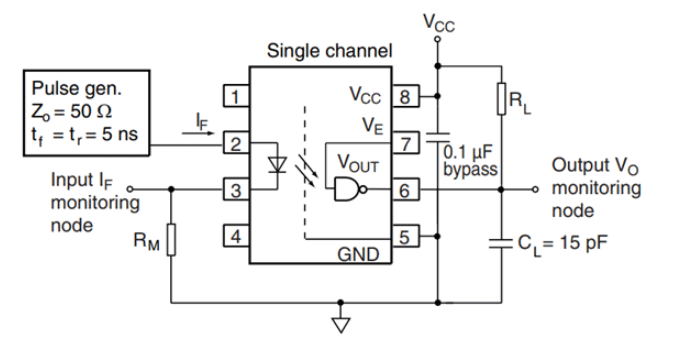
6N137 Alternatives
Where to use 6N137?
Microprocessor Systems and computer peripheral interfaces use optocoupler.
IC uses noise eliminations, data transmission, and analog to digital and digital to analog conversion.
Optocoupler 6N137 is used in strode lights of cameras.
6N137 vs. 6N138
6N137 Package
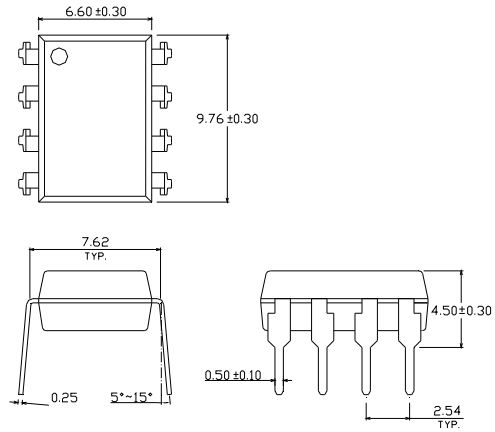
6N137 Manufacturer
Everlight Electronics Co., Ltd. was founded in 1983 in Taipei, Taiwan. Playing a critical role in the formation of the global LED industry, the company is rapidly ascending to become a leading supplier due to its dedication to certification, R&D, production, quality, marketing and global customer service. Everlight provides a diverse product portfolio consisting of High Power LEDs, Lamps, SMD LEDs, LED Lighting Modules, Digital Displays, Optocouplers and Infrared Components for various applications. Today, Everlight is a global company with over 6,400 employees based in China, Hong Kong, Japan, Korea, Singapore, Malaysia, Germany, Sweden, U.S., and Canada.
Trend Analysis
Datasheet PDF
- Datasheets :
What is 6N137?
6N137 is a single-channel high-speed optoisolator. ... This optocoupler comes up with 10Mbit/sec speed which uses as an optocoupler between two circuits for multiple purposes. IC 6N137 internally comes up IR transmitter but the receiver end comes up with an NMOS transistor which keeps it protected from leakage.
What is 6N137 used for?
IC uses noise eliminations, data transmission, analog to digital, and digital to analog conversion. Optocoupler 6N137 is used as strode lights of cameras.
How does 6N137 work?
6N137 is a photocoupler also known as optocoupler that is used to connects the two electrically isolated circuits with the help of light. It consists of 8 pins where inputs and outputs terminals are electrically isolated which helps in controlling the large power, current, and AC voltages with a small digital signal.
What is the difference between TLP521 and 6N137?
TLP521 is a controllable photoelectric coupling device. The photocoupler is widely used in computer terminals, thyristor system equipment, measuring instruments, photocopiers, automatic ticketing, household appliances, such as fans, heaters; etc. The signal transmission between the circuits completely isolates the front end from the load. The purpose is to increase safety, reduce circuit interference, and reduce circuit design. 6N137 is composed of an 850 nm wavelength AlGaAs LED and an integrated detector, and is used in a single-channel high-speed optocoupler. The integrated detector consists of a photodiode, a high-gain linear operational amplifier, and a Schottky clamp It is composed of a triode with an open collector.
 LTM2173HY-14#PBF Analog to Digital Converter: A Comprehensive Technical Overview
LTM2173HY-14#PBF Analog to Digital Converter: A Comprehensive Technical Overview06 March 2024118
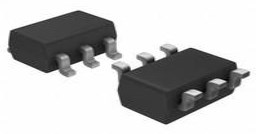 TPS2553DBVR Power-Distribution Switch: Layout, Pinout, and Datasheet
TPS2553DBVR Power-Distribution Switch: Layout, Pinout, and Datasheet25 March 20223119
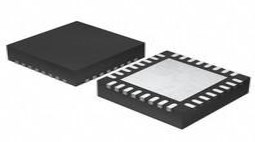 LTC4260 Hot Swap Controller: Pinout, Datasheet and Schematics
LTC4260 Hot Swap Controller: Pinout, Datasheet and Schematics14 September 20211421
 STM32F302RBT7 Microcontroller: 32-Bit, 64-LQFP, Pinout and Features
STM32F302RBT7 Microcontroller: 32-Bit, 64-LQFP, Pinout and Features18 January 2022625
 eZ80F91 Microcontroller: Product Brief and Applications
eZ80F91 Microcontroller: Product Brief and Applications28 February 2024289
![OPA2134 VS TL072[Video]: What are the differences between them?](https://res.utmel.com/Images/Article/033d2d98-5d7e-40f2-9fc3-3620ad4995f8.png) OPA2134 VS TL072[Video]: What are the differences between them?
OPA2134 VS TL072[Video]: What are the differences between them?14 April 20226653
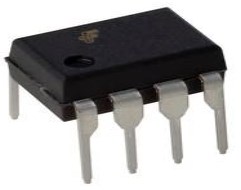 6N138 Optocouplers: Features, Pinout, and Datasheet
6N138 Optocouplers: Features, Pinout, and Datasheet15 December 20215313
 AD581: High-Precision Voltage Reference for Reliable Electronic Systems
AD581: High-Precision Voltage Reference for Reliable Electronic Systems06 March 2024127
 Introduction to BGA Package
Introduction to BGA Package07 December 20214534
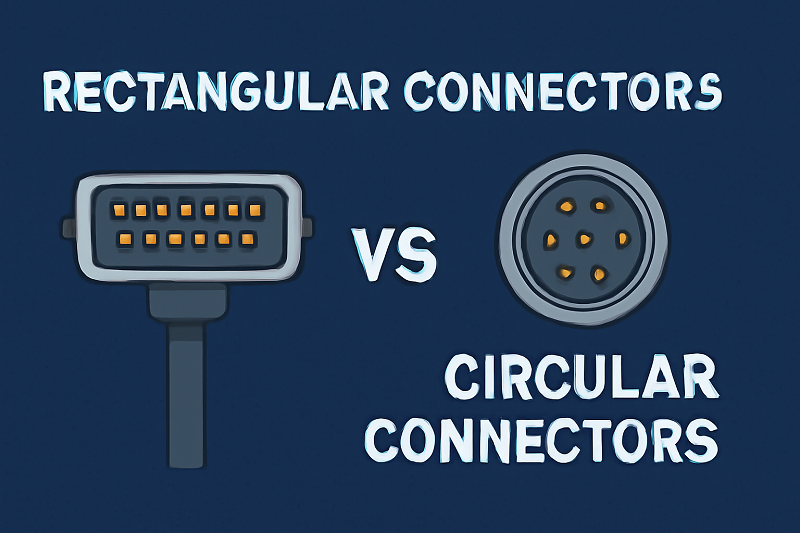 Rectangular Connectors vs Circular Connectors: Which fits your Project Best
Rectangular Connectors vs Circular Connectors: Which fits your Project Best04 July 2025607
 Insulation Approaches for Power Electronic Converters
Insulation Approaches for Power Electronic Converters12 October 20232521
 Basis of Fiber Optic and Fiber Optic Communication
Basis of Fiber Optic and Fiber Optic Communication22 October 20213233
 What is AMOLED?
What is AMOLED?25 April 20218259
 Working Principle and Types of Electric Fuse
Working Principle and Types of Electric Fuse19 August 202012591
 What are the Types and Dielectric of Ceramic Capacitors?
What are the Types and Dielectric of Ceramic Capacitors?16 October 202510731
 What is a Cell Phone Antenna?
What is a Cell Phone Antenna?21 July 202127203
Everlight Electronics Co Ltd
In Stock: 53000
United States
China
Canada
Japan
Russia
Germany
United Kingdom
Singapore
Italy
Hong Kong(China)
Taiwan(China)
France
Korea
Mexico
Netherlands
Malaysia
Austria
Spain
Switzerland
Poland
Thailand
Vietnam
India
United Arab Emirates
Afghanistan
Åland Islands
Albania
Algeria
American Samoa
Andorra
Angola
Anguilla
Antigua & Barbuda
Argentina
Armenia
Aruba
Australia
Azerbaijan
Bahamas
Bahrain
Bangladesh
Barbados
Belarus
Belgium
Belize
Benin
Bermuda
Bhutan
Bolivia
Bonaire, Sint Eustatius and Saba
Bosnia & Herzegovina
Botswana
Brazil
British Indian Ocean Territory
British Virgin Islands
Brunei
Bulgaria
Burkina Faso
Burundi
Cabo Verde
Cambodia
Cameroon
Cayman Islands
Central African Republic
Chad
Chile
Christmas Island
Cocos (Keeling) Islands
Colombia
Comoros
Congo
Congo (DRC)
Cook Islands
Costa Rica
Côte d’Ivoire
Croatia
Cuba
Curaçao
Cyprus
Czechia
Denmark
Djibouti
Dominica
Dominican Republic
Ecuador
Egypt
El Salvador
Equatorial Guinea
Eritrea
Estonia
Eswatini
Ethiopia
Falkland Islands
Faroe Islands
Fiji
Finland
French Guiana
French Polynesia
Gabon
Gambia
Georgia
Ghana
Gibraltar
Greece
Greenland
Grenada
Guadeloupe
Guam
Guatemala
Guernsey
Guinea
Guinea-Bissau
Guyana
Haiti
Honduras
Hungary
Iceland
Indonesia
Iran
Iraq
Ireland
Isle of Man
Israel
Jamaica
Jersey
Jordan
Kazakhstan
Kenya
Kiribati
Kosovo
Kuwait
Kyrgyzstan
Laos
Latvia
Lebanon
Lesotho
Liberia
Libya
Liechtenstein
Lithuania
Luxembourg
Macao(China)
Madagascar
Malawi
Maldives
Mali
Malta
Marshall Islands
Martinique
Mauritania
Mauritius
Mayotte
Micronesia
Moldova
Monaco
Mongolia
Montenegro
Montserrat
Morocco
Mozambique
Myanmar
Namibia
Nauru
Nepal
New Caledonia
New Zealand
Nicaragua
Niger
Nigeria
Niue
Norfolk Island
North Korea
North Macedonia
Northern Mariana Islands
Norway
Oman
Pakistan
Palau
Palestinian Authority
Panama
Papua New Guinea
Paraguay
Peru
Philippines
Pitcairn Islands
Portugal
Puerto Rico
Qatar
Réunion
Romania
Rwanda
Samoa
San Marino
São Tomé & Príncipe
Saudi Arabia
Senegal
Serbia
Seychelles
Sierra Leone
Sint Maarten
Slovakia
Slovenia
Solomon Islands
Somalia
South Africa
South Sudan
Sri Lanka
St Helena, Ascension, Tristan da Cunha
St. Barthélemy
St. Kitts & Nevis
St. Lucia
St. Martin
St. Pierre & Miquelon
St. Vincent & Grenadines
Sudan
Suriname
Svalbard & Jan Mayen
Sweden
Syria
Tajikistan
Tanzania
Timor-Leste
Togo
Tokelau
Tonga
Trinidad & Tobago
Tunisia
Turkey
Turkmenistan
Turks & Caicos Islands
Tuvalu
U.S. Outlying Islands
U.S. Virgin Islands
Uganda
Ukraine
Uruguay
Uzbekistan
Vanuatu
Vatican City
Venezuela
Wallis & Futuna
Yemen
Zambia
Zimbabwe







